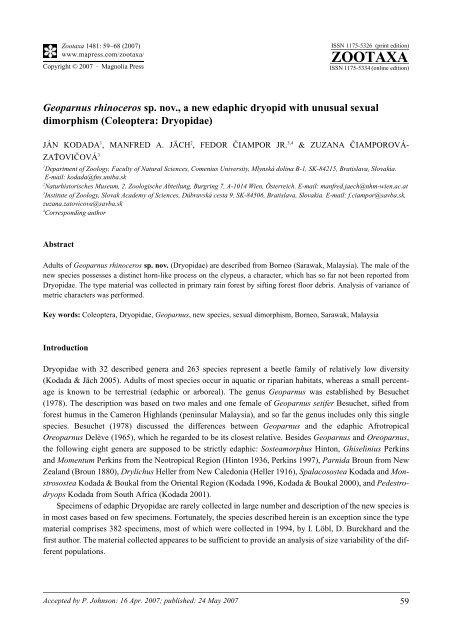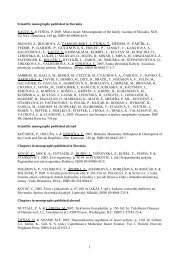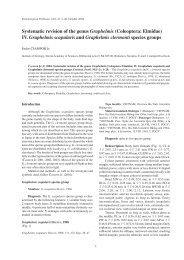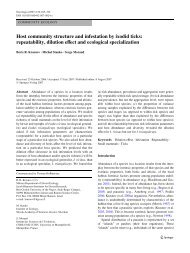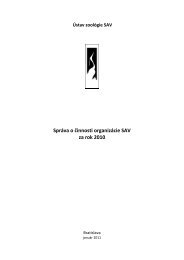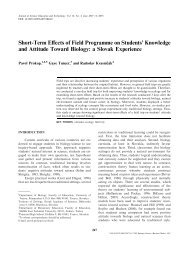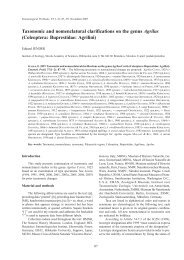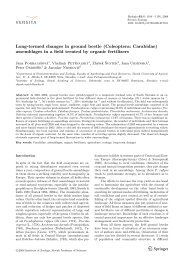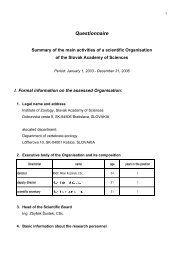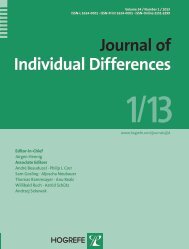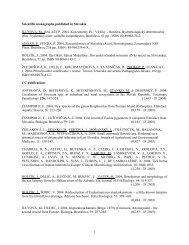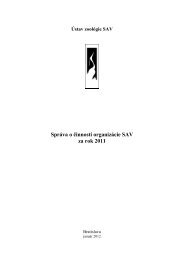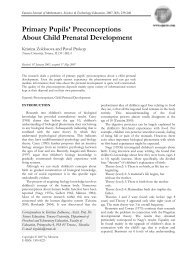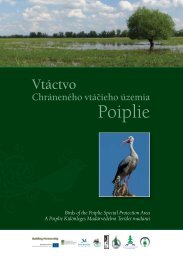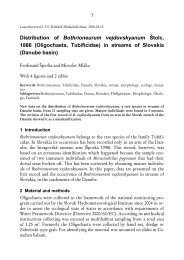Geoparnus rhinoceros sp. nov., a new edaphic dryopid with unusual ...
Geoparnus rhinoceros sp. nov., a new edaphic dryopid with unusual ...
Geoparnus rhinoceros sp. nov., a new edaphic dryopid with unusual ...
You also want an ePaper? Increase the reach of your titles
YUMPU automatically turns print PDFs into web optimized ePapers that Google loves.
Zootaxa 1481: 59–68 (2007)<br />
www.mapress.com/zootaxa/<br />
Copyright © 2007 · Magnolia Press<br />
ISSN 1175-5326 (print edition)<br />
ZOOTAXA<br />
ISSN 1175-5334 (online edition)<br />
<strong>Geoparnus</strong> <strong>rhinoceros</strong> <strong>sp</strong>. <strong>nov</strong>., a <strong>new</strong> <strong>edaphic</strong> <strong>dryopid</strong> <strong>with</strong> <strong>unusual</strong> sexual<br />
dimorphism (Coleoptera: Dryopidae)<br />
JÁN KODADA 1 , MANFRED A. JÄCH 2 , FEDOR ČIAMPOR JR. 3,4 & ZUZANA ČIAMPOROVÁ-<br />
ZAØOVIČOVÁ 3<br />
1<br />
Department of Zoology, Faculty of Natural Sciences, Comenius University, Mlynská dolina B-1, SK-84215, Bratislava, Slovakia.<br />
E-mail: kodada@fns.uniba.sk<br />
2<br />
Naturhistorisches Museum, 2. Zoologische Abteilung, Burgring 7, A-1014 Wien, Österreich. E-mail: manfred.jaech@nhm-wien.ac.at<br />
3<br />
Institute of Zoology, Slovak Academy of Sciences, Dúbravská cesta 9, SK-84506, Bratislava, Slovakia. E-mail: f.ciampor@savba.sk,<br />
zuzana.zatovicova@savba.sk<br />
4<br />
Corre<strong>sp</strong>onding author<br />
Abstract<br />
Adults of <strong>Geoparnus</strong> <strong>rhinoceros</strong> <strong>sp</strong>. <strong>nov</strong>. (Dryopidae) are described from Borneo (Sarawak, Malaysia). The male of the<br />
<strong>new</strong> <strong>sp</strong>ecies possesses a distinct horn-like process on the clypeus, a character, which has so far not been reported from<br />
Dryopidae. The type material was collected in primary rain forest by sifting forest floor debris. Analysis of variance of<br />
metric characters was performed.<br />
Key words: Coleoptera, Dryopidae, <strong>Geoparnus</strong>, <strong>new</strong> <strong>sp</strong>ecies, sexual dimorphism, Borneo, Sarawak, Malaysia<br />
Introduction<br />
Dryopidae <strong>with</strong> 32 described genera and 263 <strong>sp</strong>ecies represent a beetle family of relatively low diversity<br />
(Kodada & Jäch 2005). Adults of most <strong>sp</strong>ecies occur in aquatic or riparian habitats, whereas a small percentage<br />
is known to be terrestrial (<strong>edaphic</strong> or arboreal). The genus <strong>Geoparnus</strong> was established by Besuchet<br />
(1978). The description was based on two males and one female of <strong>Geoparnus</strong> setifer Besuchet, sifted from<br />
forest humus in the Cameron Highlands (peninsular Malaysia), and so far the genus includes only this single<br />
<strong>sp</strong>ecies. Besuchet (1978) discussed the differences between <strong>Geoparnus</strong> and the <strong>edaphic</strong> Afrotropical<br />
Oreoparnus Delève (1965), which he regarded to be its closest relative. Besides <strong>Geoparnus</strong> and Oreoparnus,<br />
the following eight genera are supposed to be strictly <strong>edaphic</strong>: Sosteamorphus Hinton, Ghiselinius Perkins<br />
and Momentum Perkins from the Neotropical Region (Hinton 1936, Perkins 1997), Parnida Broun from New<br />
Zealand (Broun 1880), Drylichus Heller from New Caledonia (Heller 1916), Spalacosostea Kodada and Monstrosostea<br />
Kodada & Boukal from the Oriental Region (Kodada 1996, Kodada & Boukal 2000), and Pedestrodryops<br />
Kodada from South Africa (Kodada 2001).<br />
Specimens of <strong>edaphic</strong> Dryopidae are rarely collected in large number and description of the <strong>new</strong> <strong>sp</strong>ecies is<br />
in most cases based on few <strong>sp</strong>ecimens. Fortunately, the <strong>sp</strong>ecies described herein is an exception since the type<br />
material comprises 382 <strong>sp</strong>ecimens, most of which were collected in 1994, by I. Löbl, D. Burckhard and the<br />
first author. The material collected appeares to be sufficient to provide an analysis of size variability of the different<br />
populations.<br />
Accepted by P. Johnson: 16 Apr. 2007; published: 24 May 2007 59
Material, methods and abbreviations<br />
The material used for this study is deposited in the following institutions (abbreviations are used to refer to<br />
collections in the text): MHNG—Muséum d’Histoire Naturelle, Genève, Switzerland; NMW—Naturhistorisches<br />
Museum Wien, Austria; SMNS —Staatliches Museum für Naturkunde, Stuttgart, Germany; CKB—<br />
Collection of Ján Kodada, Bratislava, Slovakia.<br />
Dried <strong>sp</strong>ecimens used for structural studies were soaked in warm water to which several drops of concentrated<br />
acetic acid were added, cleaned, and later exposed for several days in lactic acid. Specimens were<br />
examined under a Wild M3Z stereomicroscope <strong>with</strong> Planapo 1.0 lens, by use of diffuse lighting at magnifications<br />
up to 60 ×. Dissected male and female genitalia as well as the pregenital segments were studied as temporary<br />
glycerin slides at magnifications up to 600 × under a Carl Zeiss microscope. All drawings were made<br />
by using a drawing tube.<br />
For scanning electron microscopy <strong>sp</strong>ecimens were dehydrated in graded ethanol series and then air dried<br />
from absolute ethanol, mounted on stubs <strong>with</strong> Tempfix, <strong>sp</strong>utter coated <strong>with</strong> gold and viewed and photographed<br />
in Jeol 840A.<br />
Metric characters of 95 males and 94 females were measured <strong>with</strong> an ocular grid to the nearest 0.05 mm;<br />
data in parentheses in the description below show mean ± standard deviation calculated from whole measured<br />
material. One-way analysis of variance (ANOVA, Holm-Sidak test) or Kruskal-Wallis test were used to compare<br />
metric variables of <strong>sp</strong>ecimens from different localities and to find differences between them. Selected<br />
metric characters were analysed separately for males and females re<strong>sp</strong>ectively. Tests of assumptions for using<br />
ANOVA (Kolmogorov-Smir<strong>nov</strong> Normality test) and subsequent pairwise multiple analyses were realized by<br />
the use of the computer program SigmaStat 3.1 and values <strong>with</strong> P < 0.05 were considered significant. Sigma-<br />
Plot 9.0 was used for drawing the box & whisker plots. Abbreviations for the measured characters used in the<br />
text: BL— body length, length of pronotum and elytra measured along midline (retraction of head into prothorax<br />
show variation <strong>with</strong>in <strong>sp</strong>ecimens and depends on the conservation, drying and preparation of <strong>sp</strong>ecimens,<br />
from this reason the length of head is omitted), EL—elytral length along suture, EW—maximum elytral<br />
width, PL—pronotal length along middle, PW—maximum pronotal width.<br />
<strong>Geoparnus</strong> <strong>rhinoceros</strong> <strong>sp</strong>. <strong>nov</strong>.<br />
(Figs. 1–20)<br />
Type locality: forest floor debris in primary rain forest, close to a tributary of River Sut, about 25 km east of<br />
Kapit, Borneo, Sarawak, Malaysia.<br />
Material examined: Holotype % (NMW): ”Sarawak (Borneo), ca 25 km E Kapit, 3. 1994, J. Kodada<br />
leg.”. Paratypes 25 %%, 24 && (NMW, CKB): <strong>with</strong> the same locality data as holotype; 4 %%, 5 && (CKB):<br />
"Sarawak (Borneo), Gunung Serapi, ca 19 km W Kuching, P. Bílek leg."; 2 && (CKB): "Sarawak (Borneo),<br />
Gunung Serapi, ca 19 km W Kuching, primary forest, III. 1994, J. Kodada leg."; 106 %%, 97 && (MHNG): "E<br />
Malaysia: Sarawak, 1994 Santubong, 32 km N Kuching, 0–100 m, 11.–15.V., no 1a, Burckhardt & Löbl leg.";<br />
46 %%, 51 && (MHNG): "E- Malaysia: Sarawak, 1994, Gn. Gading, E slope, 50 m, 9 km E Lundu, 14.V., no<br />
3a, Burckhardt & Löbl leg."; 8 %%, 6 && (SMNS): "Borneo: Sarawak, Belaga 14.–16. 3. 1990 leg. A.<br />
RIEDEL"; 5 %%, 2 && (SMNS): "Borneo: Sarawak, Kuching, Santubong 26. 3. 1990 A. RIEDEL".<br />
Diagnosis (adult strage): <strong>Geoparnus</strong> <strong>rhinoceros</strong> is a medium sized <strong>sp</strong>ecies (body length 1.7–2.5 mm),<br />
unique among all known Dryopidae by the horn-like process on the head of the male. From <strong>Geoparnus</strong> setifer<br />
it differs furthermore in the following most obvious characters: (a) body form ovoid, strongly convex, moderately<br />
constricted between pronotum and elytra (G. setifer is elongate-ovate, less convex); (b) flat-bottomed<br />
punctures on head and pronotum distinctly larger than a facet, shallowly impressed (in G. setifer these punc-<br />
60 · Zootaxa 1481 © 2007 Magnolia Press<br />
KODADA ET AL.
tures are subequal to a diameter of a facet and deeply impressed); (c) scutellum concealed by elytra (in G. setifer<br />
scutellum small but well visible in dorsal view); (d) shape of male genitalia.<br />
Members of <strong>Geoparnus</strong> are characterized by combination of the following characters: (a) con<strong>sp</strong>icuous<br />
stiff setae <strong>with</strong> ridged surface and multifurcate apex; (b) short and compact body form and the antennal configuration.<br />
Description: Habitus of male as in Fig. 1. Body form ovoid, moderately constricted between pronotum<br />
and elytra, convex dorsally, very compact, strongly sclerotised; in males 1.54–1.92 (1.77±0.08) and in females<br />
1.50–1.87 (1.72±0.08) times as long as wide (BL/EW); body length (BL): %%1.73–2.40 mm (2.04±0.13), &&<br />
1.76–2.50 mm (2.08±0.13). Colour black, clypeus, antennae, mouthparts and legs paler yellowish or reddishbrown.<br />
Immature <strong>sp</strong>ecimens yellowish-brown.<br />
FIGURE 1. Habitus of <strong>Geoparnus</strong> <strong>rhinoceros</strong> <strong>sp</strong>. <strong>nov</strong>., male.<br />
NEW SPECIES OF GEOPARNUS (COLEOPTERA)<br />
Zootaxa 1481 © 2007 Magnolia Press · 61
FIGURES 2–9. <strong>Geoparnus</strong> <strong>rhinoceros</strong> <strong>sp</strong>. <strong>nov</strong>., 2) male head, dorsal view; 3) male head, lateral view; 4) pronotum, dorsal<br />
view; 5) hypomeron and part of prosternum, ventral view; 6) prothorax, ventral view; 7) meso- and metathorax, ventral<br />
view; 8) detail of flat-bottomed punctures <strong>with</strong> stiff setae, ventral view; 9) detail of stiff seta, lateral view.<br />
62 · Zootaxa 1481 © 2007 Magnolia Press<br />
KODADA ET AL.
FIGURES 10–14. <strong>Geoparnus</strong> <strong>rhinoceros</strong> <strong>sp</strong>. <strong>nov</strong>.; 10) elytron, lateral view; 11) male protibia, lateral view; 12) abdomen<br />
in male, ventral view; 13) fifth ventrite in male, ventral view; 14) fifth ventrite in female, ventral view.<br />
Vestiture of body consists of several types of distinctly different setae: (a) short and longer hair-like setae<br />
(Figs. 2, 4, 12), and (b) con<strong>sp</strong>icuous stiff shorter and longer setae <strong>with</strong> ridged surface and multifurcate apex<br />
(Figs. 8, 9); all setae yellowish. Short hair-like setae adpressed, confined mainly to clypeus, pronotum, epipleura<br />
and ventral surface of thorax and abdomen, on elytra very scarce; longer hair-like setae concentrated<br />
mainly on anterolateral portion of clypeus; all hair-like setae arising from small sockets. Con<strong>sp</strong>icuous stiff<br />
setae erect, arising either from large, flat-bottomed punctures (Figs. 2, 4, 7, 8, 12-14) on dorsal portion of<br />
NEW SPECIES OF GEOPARNUS (COLEOPTERA)<br />
Zootaxa 1481 © 2007 Magnolia Press · 63
head, pronotum, meso- and metaventrite and partly on ventrites, or from small sockets on elytra, legs, pedicell,<br />
central portion of ventrites and lateral parts of pronotum.<br />
Head: Clypeus <strong>with</strong> fine punctures and fine reticulation; anterior margin produced dorsad forming a hornlike<br />
process in male (Figs. 2, 3), arcuate and unproduced in female; surface around antennal insertion raised in<br />
male, nearly flat in female; frons and vertex <strong>with</strong> flat-bottomed large punctures, punctures ca. 3–4 times as<br />
wide as a diameter of a facet, punctures dense but distinctly separated from each other, interstices <strong>with</strong> fine<br />
punctures and short setae. Compound eyes moderately protruding from head outline, small, <strong>with</strong> few setae.<br />
Antennal insertion deep, scape short, pedicell enlarged, dorsally flat; antennal club moderately longer than<br />
scape and pedicell combined, nine-segmented.<br />
FIGURES 15–20. <strong>Geoparnus</strong> <strong>rhinoceros</strong> <strong>sp</strong>. <strong>nov</strong>.; 15 – 16) Aedeagus, ventral and lateral view; 17) ninth sternite in<br />
male, ventral view; 18) ovipositor, lateral view; 19) eighth sternite in male, ventral view; 20) eighth sternite in female,<br />
ventral view. Scale = 0.1 mm.<br />
64 · Zootaxa 1481 © 2007 Magnolia Press<br />
KODADA ET AL.
FIGURES 21–22. 21) Box & Whisker plots showing the variability of body length of males at all localities; statistically<br />
significant differences between two morphological forms were detected. Plots show medians (solid horizontal line),<br />
means (dash lines), 25 th and 75 th percentiles (boxes), 10 th and 90 th percentiles (whisker extending from boxes), and 5 th and<br />
95 th percentiles (outliers); 22) Box & Whisker plots showing the variability of body length/ elytral width ratio of males;<br />
no distinct morphological forms were detected.<br />
Thorax: Pronotal disc strongly convex; PL: %% 0.60–0.79 mm (0.70±0.05), && 0.50–0.76 mm<br />
(0.68±0.05); PW: %% 0.97–1.40 mm (1.13±0.08), && 0.95–1.30 mm (1.15±0.07); lateral sides arcuate, crenulate;<br />
anterior margin of pronotum straight; anterior corners deflected, short and acute, moderately protruding;<br />
posterior margin bisinuate; posterior corners short; punctation similar to that on vertex but less dense.<br />
Hypomeron widest posteriorly, <strong>with</strong> scattered larger punctures (Fig. 5); prosternum in front of coxae as long<br />
as prosternal process, strongly punctate (Fig. 6); prosternal process longer than wide, lateral sides raised, apex<br />
subacute, surface densely punctate. Meso- and metaventrite very short (Fig. 7), together shorter than prosternum,<br />
mesal portion deeply impressed, lateral portions <strong>with</strong> large punctures, interstices <strong>with</strong> fine reticulation.<br />
Elytra convex, <strong>with</strong>out humeri; strongly declivitous laterally and posteriorly; lateral sides crenulate and visible<br />
in dorsal view to posterior margin of mesocoxa; apices moderately produced, acute; each elytron <strong>with</strong> nine<br />
rows of coarse, large, deeply impressed punctures, punctures about as coarse as those on pronotum but less<br />
sharply delimited and not flat-bottomed, often somewhat subquadrate; interstices on central portion usually<br />
less than half as wide as puncture diameter, laterally and posteriorly becoming narrower; intervals distinctly<br />
narrower than punctures in rows, feebly raised, <strong>with</strong> rows of stiff erect setae; anterior margin arcuate; scutellum<br />
concealed by elytra, inserted into cavity in sutural edge of each elytron. Epipleura anteriorly as wide as<br />
maximum width of profemur, narrowed posteriad, effaced near fifth ventrite, inflected at level of metacoxa,<br />
surface finely punctate. EL: %% 1.12–1.60 mm (1.33±0.11), && 1.15–1.70 mm (1.39±0.11); EW: %% 0.95–<br />
1.30 mm (1.16±0.09), && 1.05–1.40 mm (1.21±0.09). Hind wings fully absent. Foreleg longest, moderately<br />
shorter than body; middle and hind legs slightly shorter; protibia feebly longer than profemur, straight or<br />
slightly bent and moderately thickened in both sexes (Fig. 11); meso- and metatibia similar in form but<br />
shorter, <strong>with</strong> a small ventrodistal tooth in male; combined length of protarsomeres and claws moderately<br />
exceeds half length of protibia; claws of foreleg in male wider than in female.<br />
Abdominal intercoxal process (Fig. 12) moderately wider than prosternal process, apex subtruncate, lateral<br />
sides raised; first ventrite in middle slightly longer than second and third ventrite together; fourth ventrite<br />
about half as long as first one and nearly third as long as fifth ventrite; fifth ventrite more rounded and sides<br />
less declivous in male than in female (Figs. 13, 14); surface of ventrites <strong>with</strong> large flat-bottomed punctures<br />
and micropunctures, setose. Eighth sternite <strong>with</strong> short median process in male (Fig. 19) and long in female<br />
(Fig. 20); ninth sternite narrow and long in male (Fig. 17).<br />
NEW SPECIES OF GEOPARNUS (COLEOPTERA)<br />
Zootaxa 1481 © 2007 Magnolia Press · 65
FIGURE 23. Known distribution of <strong>Geoparnus</strong> <strong>rhinoceros</strong> <strong>sp</strong>. <strong>nov</strong>. in Sarawak.<br />
Aedeagus (Figs. 15, 16): phallobasis robust, subcylindrical, moderately curved, 1.5–1.8 times as long as<br />
parameres, basally wider than apically (lateral view). Parameres moderately long, widest basally, gradually<br />
curved ventrad and gradually narrowed toward apices; apices subtruncate in lateral view. Penis distinctly<br />
shorter than parameres, widest basally, gradually narrowed apically; apex nearly acute (ventral view). Membranous<br />
ventral sac <strong>with</strong> fine longitudinal furrows; fibula absent. Ovipositor (Fig. 18) distinctly longer than<br />
abdomen; valvifer about 1.5–1.7 times as long as coxite; bursa copulatrix <strong>with</strong>out sclerotised <strong>sp</strong>inules.<br />
Sexual dimorphism. Males <strong>with</strong> horn-like process on clypeus and tibial teeth, on average shorter, narrower<br />
and less convex than females (see BL, EW in Tabs. 1, 2).<br />
Habitat. Specimens were collected by sifting ground debris containing leaf litter, decaying twigs, remnants<br />
of epiphytes, bark and other plant material accumulated mainly around large, living or dead trees. Most<br />
<strong>sp</strong>ecimens were found in primary lowland forest.<br />
Distribution. The <strong>sp</strong>ecies is known from several localities in central and southwestern Sarawak (Fig. 23).<br />
Etymology. Named in reference to the horn-like process on the male clypeus.<br />
Variability. Analysis of variance showed significant differences among populations <strong>with</strong>in all measured<br />
characters (Tabs. 1, 2). The multiple comparison procedures revealed different results regarding sex.<br />
TABLE 1. Variability of selected metric characters in males of <strong>Geoparnus</strong> <strong>rhinoceros</strong> <strong>with</strong> results of one way analysis of<br />
variance (BL—body length, EL—elytral length along suture, EW—maximum elytral width, PL—pronotal length along<br />
middle, PW—maximum pronotal width; first rows show ranges of measured values for <strong>sp</strong>ecimens for different localities,<br />
in second rows mean and standard deviation for the re<strong>sp</strong>ective measurements, n—number of measured <strong>sp</strong>ecimens, F—<br />
Fisher`s value, H—the ANOVA on Ranks test statistics, P—probability).<br />
Locality BL [mm] EL [mm] EW [mm] BL/EW PL [mm] PW [mm] PL/PW<br />
Belaga 1.74–2.00 1.12–1.30 0.96–1.10 1.72–1.91 0.61–0.66 0.97–1.11 0.61–0.65<br />
n = 9 1.852 ± 0.104 1.187 ± 0.077 1.034 ± 0.044 1.791 ± 0.061 0.659 ± 0.036 1.049 ± 0.043 0.628 ± 0.013<br />
25 km E Kapit 1.76–2.07 1.12–1.30 1.00–1.14 1.73–1.90 0.64–0.76 0.97–1.12 0.62–0.72<br />
n = 20 1.926 ± 0.075 1.236 ± 0.052 1.075 ± 0.041 1.792 ± 0.053 0.690 ± 0.029 1.051 ± 0.038 0.657 ± 0.023<br />
Gunung Gading 1.95–2.40 1.30–1.60 1.10–1.30 1.54–1.92 0.60–0.75 1.05–1.40 0.48–0.64<br />
n = 32 2.131 ± 0.105 1.445 ± 0.072 1.231 ± 0.061 1.733 ± 0.087 0.670 ± 0.045 1.180 ± 0.074 0.569 ± 0.041<br />
Santubong 1.89–2.27 1.19–1.48 1.06–1.29 1.56–1.88 0.66–0.79 1.06–1.25 0.58–0.69<br />
n = 31 2.072 ± 0.096 1.328 ± 0.069 1.168 ± 0.060 1.777 ± 0.087 0.744 ± 0.037 1.150 ± 0.054 0.648 ± 0.030<br />
Gunung Serapi 1.99–2.19 1.28–1.43 1.11–1.17 1.80–1.88 0.71–0.76 1.08–1.17 0.66–0.67<br />
n = 3 2.092 ± 0.102 1.344 ± 0.078 1.136 ± 0.030 1.840 ± 0.041 0.748 ± 0.029 1.131 ± 0.049 0.662 ± 0.005<br />
F = 24.04 H = 61.17 H = 59.20 H = 13.11 H = 45.13 H = 46.79 H = 58.58<br />
P < 0.001 P < 0.001 P < 0.001 P = 0.011 P < 0.001 P < 0.001 P < 0.001<br />
66 · Zootaxa 1481 © 2007 Magnolia Press<br />
KODADA ET AL.
In males pairwise multiple comparison tests of body length (BL), elytral length (EL) and maximum elytral<br />
width (EW) showed two morphological forms: (1) smaller and narrower males from central Sarawak<br />
(Belaga, Kapit env.) and (2) larger and wider males from southwestern Sarawak near Kuching (Gunung Gading,<br />
Santubong, Gunung Serapi). These groups are also evident from Box & Whisker plots of the data variability<br />
(BL—Fig. 21; plots of EL and EW not shown). Pairwise multiple analyses of maximum pronotal width<br />
(PW) and length (PL) suggest the same groups, <strong>with</strong> some exceptions: the conflicting comparisons always<br />
included males from Gunung Serapi, which is likely caused by insufficient data from this locality (n=3). Subsequent<br />
comparisons of the pooled data of both groups (using t-test) confirmed these two distinct morphological<br />
forms—significant differences were found <strong>with</strong>in all tested metric characters (BL, EL, EW, PW <strong>with</strong><br />
P
not confirmed. It must also be noted, that all <strong>sp</strong>ecimens in each of the populations were collected together<br />
from site of several square meters, and thus the differences could be due to idiosyncratic conditions of the<br />
sample rather than to a geographic cline (i.e. the particular conditions of the development of the <strong>sp</strong>ecimens in<br />
the sample).<br />
Except variations in metric characters, in a few <strong>sp</strong>ecimens elytral punctures are irregularly arranged when<br />
comparing left and right elytron and punctures are partly confluent.<br />
Acknowledgements<br />
Our sincere thanks are due to Ivan Löbl (MHNG) and Wolfgang Schawaller (SMNS) for providing the material<br />
for this study. Special thanks are due to Jozef Stankovič (Comenius University, Bratislava) for his technical<br />
assistance by electron microscopy and Willi Zelenka (Wien) for the habitus drawing of <strong>Geoparnus</strong>. Peter<br />
Degma (Comenius University, Bratislava) is thanked for his help in statistical analyses. We are obliged to Ivan<br />
Löbl for information about the habitat. Financial support was provided partly by the Slovak Scientific Grant<br />
Agency, Project No. 1/3278/06.<br />
References<br />
Besuchet, C. (1978) Description d'un Dryopidae terrestre nouveau de la Malaisie (Coleoptera). Revue Suisse de Zoologie,<br />
85(4), 705–709.<br />
Broun, T. (1880) Manual of the New Zealand Coleoptera (Part 1). Colonial Museum and Geological Survey Department,<br />
Wellington, i–xiii+651 pp.<br />
Delève, J. (1965) Contribution à l'étude des Dryopoidea XIV. Un nouveau genre de Dryopidae (Coleoptera), à caractères<br />
aberrants. Bulletin et Annales de la Société royale d'Entomologie de Belgique, 101(14), 267–273.<br />
Heller, K.M. (1916) Die Käfer von Neu-Caledonien und den benachbarten Inselgruppen. In Sarasin, F. & Roux, J. (Eds),<br />
Nova Caledonia II. C.W. Kreidels, Wiesbaden, pp. 284–285.<br />
Hinton, H.E. (1936) Descriptions of <strong>new</strong> genera and <strong>sp</strong>ecies of Dryopidae (Coleoptera). Transactions of the Royal Entomological<br />
Society of London, 85, 415–434+1 pl.<br />
Kodada, J. (1996) Spalacosostea, an anomalous <strong>new</strong> terrestrial <strong>dryopid</strong> from South-East Asia (Coleoptera: Dryopidae).<br />
Revue suisse de Zoologie, 103(3), 581–605.<br />
Kodada, J. (2001) Pedestrodryops endroedyi gen. et. <strong>sp</strong>. <strong>nov</strong>., a <strong>new</strong> terrestrial, wingless <strong>dryopid</strong> from South Africa<br />
(Coleoptera: Dryopidae). Entomological Problems, 32(1), 37–44.<br />
Kodada, J. & Boukal, D.S. (2000) Monstrosostea solivaga <strong>new</strong> genus and <strong>sp</strong>ecies of aberrant terrestrial <strong>dryopid</strong> from<br />
southern India (Coleoptera: Dryopidae). Entomological Problems, 31(2), 129–136.<br />
Kodada, J. & Jäch, M.A. (2005) 18.2. Dryopidae. In: Beutel, R.G. & Leschen, R.A.B. (Eds), Coleoptera, Beetles Volume<br />
1: Morphology and Systematics (Archostemata, Adephaga, Myxophaga, Polyphaga partim). Handbuch der Zoologie,Band<br />
IV Arthropoda: Insecta Teilband 38, Walter de Gruyter, Berlin-New York, pp. 496–508.<br />
Perkins, P.D. (1997) Momentum and Ghiselinius, New Neotropical Genera of Humicolous Beetles <strong>with</strong> Remarkable and<br />
Divergent Mouthparts (Coleoptera: Dryopidae). Studies on Neotropical Fauna and Environment, 32, 100–117.<br />
68 · Zootaxa 1481 © 2007 Magnolia Press<br />
KODADA ET AL.


